|
|
| Übersicht – Contents: | |
|
|
| Übersicht – Contents: | |
Flaggen – Flags: |
|
 |
National-, Staats und Handelsflagge – national, state and merchant flag, Seitenverhältnis – ratio = 1:2, Quelle/Source, nach/by: Flags of the World   |
 |
Flagge der Verteidigungskäfte – flag of the Defense Forces, Seitenverhältnis – ratio = 1:2, Quelle/Source, nach/by: Flags of the World |
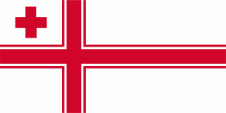 |
Marineflagge – naval flag, Seitenverhältnis – ratio = 1:2, Quelle/Source, nach/by: Flags of the World |
 |
Zollflagge – customs flag, Seitenverhältnis – ratio = 1:2, Quelle/Source, nach/by: Flags of the World |
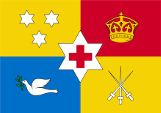 |
Flagge des Monarchen – flag of the Sovereign, Seitenverhältnis – ratio = 26:37, Quelle/Source, nach/by: Flags of the World |
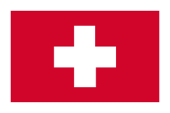 |
Flagge des Prämierministers – flag of the Prime Minister, Seitenverhältnis – ratio = 2:3 (?), Quelle/Source, nach/by: Die Welt im bunten Flaggenbild |
historische Flaggen – historical Flags: |
|
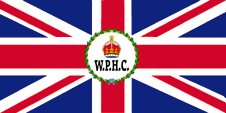 |
1905–1953, Flagge des Hohen Kommissars für den Westpazifik – flag of Western Pacific High Commissioner, Seitenverhältnis – ratio = 1:2, Quelle/Source, nach/by: Flags of the World |
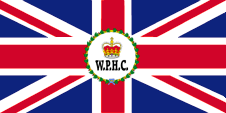 |
1953–1976, Flagge des Hohen Kommissars für den Westpazifik – flag of Western Pacific High Commissioner, Seitenverhältnis – ratio = 1:2, Quelle/Source, nach/by: Flags of the World |
 |
ca.1850–1862, Flagge von Tonga – flag of Tonga, Quelle/Source, nach/by: Flags of the World |
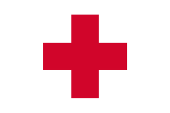 |
1862–1866, Flagge von Tonga – flag of Tonga, Quelle/Source, nach/by: World Statesmen |
| Die heutige Flagge Tongas wurde wahrscheinlich 1866 eingeführt und am 04.11.1875 erstmals per Gesetz (Verfassung) bestätigt. Wann diese Flagge eingeführt worden ist, ist nicht genau bekannt. Quellen nennen die Jahre 1864, 1866 oder sogar erst 1875. Die Flagge war 1862 – nach anderen Quellen 1864 – durch den britschstämmigen Premierminister Reverend S. W. Baker geschaffen worden und zeigt ein rotes Grundtuch mit einer weißen Oberecke, darin ein schwebendes rotes Kreuz, wobei wahrscheinlich der Britische Red Ensign als Vorbild diente. Das Kreuz und auch die Farbe Rot symbolisieren das von Jesus Christus zur Erlösung der Menschen vergossene Blut. So zumindest ist es durch König Georg Tupou I. (1797–1893), dem Vater der Verfassung, überliefert. Laut Verfassung von 1875 darf die Flagge von Tonga niemals verändert werden. Die christliche Symbolik wurde durch König Taufa'ahau Tupou um 1850 in die Flagge von Tonga gebracht, eine weiße Flagge mit einem blau-roten Monogramm und vier roten und blauen Kreuzen. Er vereinigte die drei ursprünglichen Königreiche auf den Inseln und nahm 1831 den christlichen Glauben an. Das vorhegehende Modell, die 1862 eingeführte Flagge, zeigte nur ein einziges, großes, schwebendes rotes Kreuz in der Mitte. Angeblich musste wenige Jahre das heutige Design eingefüht werden, um eine Übereinstimmung dieser Flagge mit der Flagge der Internationalen Organisation des Roten Kreuzes (gegr. 1863) zu vermeiden. Die in den meisten sorgfältigen, mehrfarbigen Reproduktionen der Flaggen von Tonga gezeigten Farben (teilweise auch im Wappen), lassen die Vermutung zu, dass sich Tonga bei den Farben und Fartönen am britischen Farbsystem orientiert, also das Farbsystem des Britischen Verteidigungsministeriums gültig ist. Das sieht vor, für Rot = Pantone 186 c, für Mittelblau = Pantone 300 c und für Tiefgelb = Pantone 116 c. |
The today's flag of Tonga
was probably introduced in 1866 and was first confirmed by law
(constitution) on 4th of November in 1875. It is not exactly known when this
flag was introduced. Sources mention the years 1864, 1866 or even as late as
1875. The flag was created in 1862 – according to other sources in 1864 – by the British-born Prime Minister Reverend S. W. Baker and shows a red base bunting with a white upper corner, with a floating red cross inside, probably the British Red Ensign served as a model. The cross and the colour red symbolize the blood shed by Jesus Christ to redeem people. At least that is what King George Tupou I. (1797–1893), the father of the constitution, passed down. According to the 1875 constitution, the flag of Tonga may never be changed. Christian symbolism was brought into the flag of Tonga by King Taufa'ahau Tupou around 1850, a white flag with a blue and red monogram and four red and blue crosses. He united the then three kingdoms on the islands and adopted the Christian faith in 1831. The previous model, the flag introduced in 1862, featured only a single, large, floating red cross in the center. Supposedly the current design had to be introduced a few years ago in order to avoid a coincidence of this flag with the flag of the International Organization of the Red Cross (founded in 1863). The colours shown in most of the careful, multi-coloured reproductions of the flags of Tonga (sometimes also in the coat of arms) suggest that Tonga's colours and colour-shades are based on the British colour system, so that the British Ministry of Defense colour system would be used. This purports for red = Pantone 186 c, for medium blue = Pantone 300 c and for deep yellow = Pantone 116 c. |
|
Quelle/Source: Die Welt der Flaggen, Flaggen Wappen Hymnen, Wikipedia (EN) |
|
Wappen – Coat of Arms: |
|
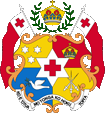 |
seit/since 1862, Wappen von Tonga – coat of arms of Tonga, Quelle/Source: Corel Draw 4 |
| Das heutige Staats- und Königswappen wurde im Jahre 1862 von Prinz Uelingatoni Ngu Tupou entworfen. Es zeigt in einem sechszackigen weißen Mittelstern ein schwebendes rotes Kreuz. Die vier Felder des Schildes zeigen: Feld 1: drei silberne Sterne auf Gold (sie stehen für die drei ursprünglichen Königreiche auf den Inseln), Feld 2: die Königskrone auf Rot (sie steht für die Monarchie), Feld 3: eine silberne Taube mit einem Myrthenzweig auf Blau (Symbol des Friedens und Missionsemblem), Feld 4: drei sich kreuzende silberne Schwertern auf Gold (sie stehen ebenfalls für die von König Taufa'ahau Tupou vereinigten drei Königreiche). Unterhalb ein Spruchband, darauf das Motto des Landes: "Ko e ʻOtua mo Tonga ko hoku Tofiʻa." → "Gott und Tonga sind mein Erbe". |
The today's national and
royal coat of arms was designed in 1862 by Prince Uelingatoni Ngu Tupou. It
features a floating red cross in a six-pointed white central star. The four fields of the shield show: Field 1: three silver stars on gold (they represent the three original kingdoms on the islands), field 2: the royal crown on red (it stands for the monarchy), field 3: a silver dove with a myrtle branch on blue (symbol of peace and mission emblem), field 4: three crossing silver swords on gold (they also represent the three kingdoms united by King Taufa'ahau Tupou). Below is a banner with the country's motto on it: "Ko e 'Otua mo Tonga ko hoku Tofi'a." → "God and Tonga are my inheritance". |
|
Quelle/Source: Die Welt der Flaggen, Flaggen Wappen Hymnen |
|
Landkarte – Map: |
Lage – Position: |
Landkarte des Landes – Map of the Country: |
|
|
| Zahlen und Fakten – Numbers and Facts: | |
|
|
|
|
|
|
|
|
|
|
|
|
|
|
|
|
|
Antike
· Besiedlung durch Polynesier Mittelalter · Herausbildung des Königreichs Tonga, später Zerfall in drei verschiedene Königreiche 28.04.1616 · Entdeckung durch den niederländischen Seefahrer Willem Schouten 21.01.1643 · der niederländische Seefahrer A. J. Tasman betritt die Inseln, so Tongatapu (er nennt sie Amsterdam), Euva (Middleburg) und Nomuka (Rotterdam) 02.10.1773 · Wiederentdeckung der Inseln durch den britischen Seefahrer James Cook, er nennt sie Freundliche Inseln (Friendly Islands) 1797 · englische Missionare beginnen ihre Arbeit 1820–1845 · Vereinigung der Inselkönigreiche unter König Taufa'ahau 1855 · Freundschaftsvertrag mit Frankreich 1875 · erste Verfassung, Tonga wird konstitutionelle Monarchie 1876 · Freundschaftsvertrag mit dem Deutschen Reich, 1977 bestätigt 1877 · Großbritannien erklärt die Inseln zum Bestandteil der Britischen Westpazifischen Territorien 1886 · Berliner Kongress, Tonga wird zum neutralen Gebiet erklärt 19.05.1900 · Tonga wird offiziell britisches Protektorat, offizielle Angliederung an die Britischen Westpazifischen Territorien 1952 · Tonga wird aus den Britischen Westpazifischen Territorien ausgegliedert 05.06.1970 · Großbritannien gewährt die Unabhängigkeit 1999 · Tonga wird Mitglied der UNO |
|
antiquity
· settlement by Polynesians middle ages · evolution of the Kingdom of Tonga, later disintegration in three different kingdoms 28th of April in 1616 · discovery by the Dutch seafarer Willem Schouten 21st of Januar in 1643 · the Dutch seafarer A. J. Tasman visits the islands, so Tongatapu (he names it Amsterdam), Euva (Middleburg) and Nomuka (Rotterdam) 2nd of October in 1773 · rediscovery of the islands by the British seafarer James Cook, he names them Friendly Islands 1797 · English missionaries start their work 1820–1845 · unification of the island's kingoms under King Taufa'ahau 1855 · friendship treaty with France 1875 · first constitution, Tonga becomes a constitutional monarchy 1876 · friendship treaty with the German Empire, in 1977 confirmed 1877 · United Kingdom declares the islands to a component of the British Western Pacific Territories 1886 · Berlin Congress, Tonga becomes declared for a neutral area 19th of May in 1900 · Tonga becomes officially a British protectorate, official incorporation to the British Western Pacific Territories 1952 · Tonga becomes separated from the British Western Pacific Territories 5th of June in 1970 · United Kingdom grants independence 1999 · Tonga becomes a member of the UNO |
| Quelle/Source: Discovery '97, Wikipedia (DE), Volker Preuß |
| Der Name Tonga bedeutet in der Sprache der Eingeborenen "Süden". So ist zu erkennen, dass die Richtung der Besiedlung aus dem Norden (Samoa) gekommen ist. |
The name Tonga means
"south" in the native language. This shows that the direction of settlement
came from the north (Samoa). |
| Quelle/Source: Handbuch der geographischen Namen | |